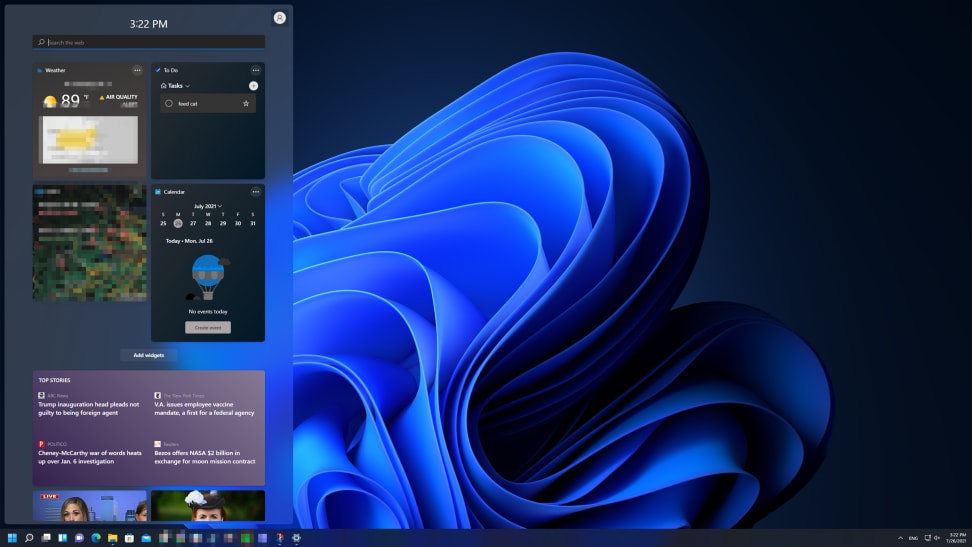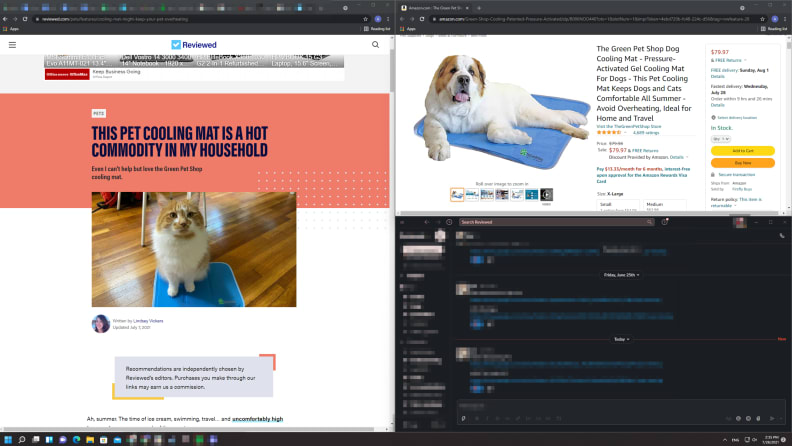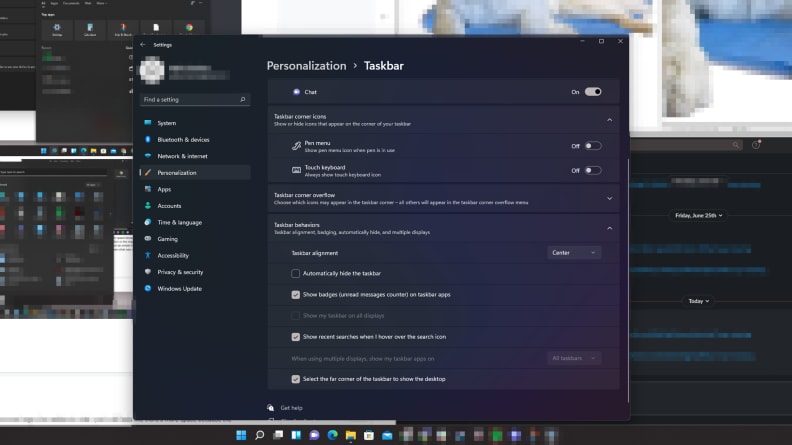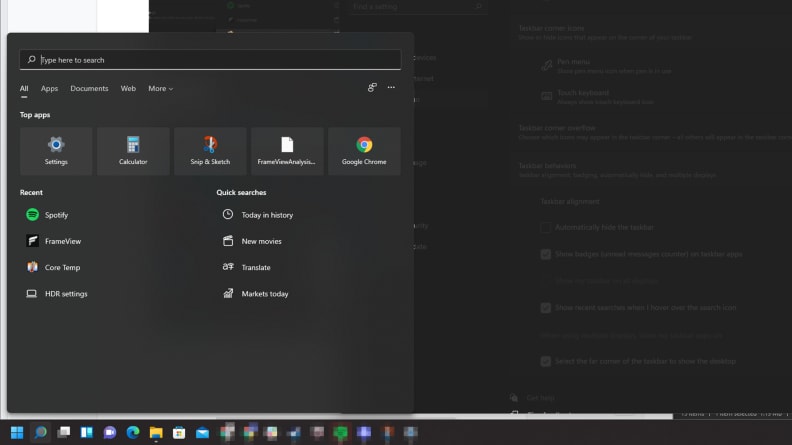Hasta la vista, Windows 10—Windows 11 is awesome
We went hands-on with Windows 11 and were seriously impressed.
 Credit:
Reviewed / Microsoft
Credit:
Reviewed / Microsoft
Products are chosen independently by our editors. Purchases made through our links may earn us a commission.
When Microsoft announced Windows 11, we had some skepticism. We weren't sure if any of the new features would actually be useful, or if we'd get used to the centered icons on the taskbar. We were also worried about the stability of the new operating system. But to our surprise, after spending the last few weeks with Windows 11, we’re elated to say it's surprisingly good and stable for a developer build.
Its menus are easier and faster to navigate, it has new features designed around streamlining your workflow, it updates automatically, and it looks as sleek as the competition. Microsoft does caution users about potential bugs and glitches since Windows 11 is currently only available to Windows Insiders who sign up for the Dev track, but we did not experience anything that seriously compromised our experience with the operating system.
Editor's Note: Because it’s in its early stages, it’s possible some Windows 11 features discussed below will either be updated or removed before the final build. You can see what’s new at any time on Microsoft’s Windows Insider Blog. Helping the new OS build and grow is part of the fun!
A new settings menu that's simpler to navigate

Windows 10 has multiple menus set up in different locations in the OS just for users to complete one task. Take the Settings menu and the Control Panel, for example. Not only can you adjust your power options and other settings from both locations, but you also need to dive into the Device Manager to find the advanced options—which is another open window cluttering your desktop. Windows 11 finally lets go of the Control Panel, a holdover from Windows 3.1 for nearly 30 years. (Technically you can still access it by pressing Win+R and typing “control,” or searching “control panel” in Windows search.)
There is only one Settings menu now, which is well organized and easy to navigate. If a setting is not in the Settings menu, then it will be under the “more settings” option, which is the same as Windows 10’s “advanced options” except there's no special pop-up window anymore. As another example, More Settings lets you disable audio devices, but the regular settings menu can do the rest. Because so many of the options in Advanced Options have been migrated to Windows 11’s regular Settings menu, we found ourselves digging through More Settings less than we dug through Advanced Options in Windows 10.

Oddly enough, this cleanup didn’t make its way to the desktop's right-click menu. While the main settings menu has been streamlined to be a central hub, Windows 11’s desktop right-click menu stripped away actions—notably the graphics card’s control panel—and hid the Windows 10 right-click menu under “More options”. Microsoft could have just thrown in the “NVIDIA Control Panel” button onto the Windows 11 right-click menu, and then there would be no need for the “Show more options” menu.
Window snapping is better at streamlining workflow

Microsoft's move to integrate window snapping in Windows 7 made comparing documents and splitting screens a smooth experience, letting windows snap to the left or right half the screen, auto-maximize, and so forth. Windows 11 has finally added the option to place your windows into more preset snap configurations, so you can see more than two on the same screen at once.
There are six presets, with one window taking up each of the highlighted areas in the preset. If you often find yourself with several programs open, you’re going to want to take advantage of this. For instance, you could have your main task on the biggest-sized window on the left, the top right corner reserved for research and background noise, and the bottom right corner for instant messaging. How-to guides, Spotify, Twitch, articles, and code are all perfect for those smaller sections.

On Windows 10, you'd need to resize the windows manually to get something similar to Windows 11’s presets. But with the new snapping system, you can save a lot of time you'd otherwise spend adjusting windows until they’re perfectly placed. Our one gripe about the snap system is that the presets menu only activates for some apps (Chrome and first-party apps have worked so far while Spotify, Slack, and Discord haven’t). Hopefully, it will work for all (or at least more) apps by the time Windows 11 launches publicly.
File Explorer & Taskbar are streamlined, too

The icons are larger, the taskbar is wider, yet it still feels like there’s more space because the search bar is gone. (Don’t worry: press the Windows button or the magnifying glass on the bottom left to do a system/web search.) In practice, it's just as simple to use as Windows 10’s taskbar, but Windows 11’s larger icons make it easier to see what's open at a glance.
Microsoft has made some substantial changes to the right side of the taskbar in Windows 11, too. The sound and internet icons are now part of a quick settings menu, which is reminiscent of the quick settings in the corner of Apple’s operating systems introduced with macOS Big Sur. You can access volume, internet connection, Bluetooth connection, focus assist, night light, and more. Depending on what you use, you can even customize which settings you can access in the quick settings menu.
Sticklers for minimalism should really appreciate the ability to turn off tiles as needed. Because we used Windows 11 on a desktop PC, we turned off airplane mode, mobile hotspot, and project, all of which we find most useful on laptops. While that doesn’t mean you lose access to them; you can still access them in the regular settings menu, or re-enable them in the quick settings.

Meanwhile, File Explorer trimmed down its options ribbon to a single row. Windows 10 had split the ribbon into File, Home, Share, View, and file-specific Manage rows. All of the options in those rows are laid bare in Windows 11’s ribbon, making it quick and easy to manipulate files.
However, Windows 11 crams in all the operations by removing the labels and leaving only icons. That’s fine for power users, but most people will take a while to remember what some icons mean without hovering over them. Copy, Paste, and Trash are recognizable, but Rename and Sort are less universal. There isn’t any change to the functionality of File Explorer, so the changes feel superficial after a couple of days.
Widgets are overhyped but still useful
The biggest change to widget functionality is that you can pick which tiles you want to be shown in Windows 11 right on the widgets page, whereas in Windows 10 you would have to go to the Settings menu to configure your widgets. The new To-Do and Calendar widgets are especially useful, allowing you to see what you have scheduled at a glance. Adding new tasks is dead easy: just click the plus sign in the widget corner.
However, the Calendars widget didn’t pick up my test event, even after refreshing the widget and Google calendar page. In the future, we’d love to see Microsoft allow third-party widgets so you can receive the functionality you need, from widgets for multiple time zones to widgets for app updates or screen time measurements.
Windows 11 updates are less intrusive (and harder to delay)
Windows 11 updates have so far been painless. The OS is finally smart enough to figure out active hours and when to install updates so they don’t happen while you’re using your PC. (Windows 10 suggests your active hours, but it ultimately requires users to set their active hours manually.)
Throughout my weeks of Windows 11, I have not once had to schedule an update, but my OS is always on the latest version available. With Windows 10, it was relatively common for the updates to fail at night, meaning you'd need to restart and apply updates the next morning when I logged on.
Sadly, there are fewer options to pause or delay updates compared to Windows 10, but at least it’s less intrusive.
Things to keep in mind before you install Windows 11
If you sign up for an insider build, you should expect to find bugs. Some users report frozen taskbars, features or menus that won’t load, and incompatibility with firmware or peripheral devices.
Most of the issues we've encountered have been taskbar-related: Taskbar app icons pop in and out when apps are launched, it takes a few seconds for the start menu to load, and hovering over apps sometimes doesn't highlight them. However, the actual functionality of the taskbar has been fine—clicks register, apps launch, and apps stay pinned.
We can’t predict what other weird issues will arise, so we recommend installing Windows 11 on a secondary PC and backing up all your data. (You’ll also need a backup of all your Windows 10 data should you decide to go back to Windows 10; Microsoft has not yet implemented a system where you can keep your files if you downgrade from Windows 11 to Windows 10.)

As part of the Windows Insider Program, Microsoft collects data on your PC usage. Microsoft relies on this data to make Windows 11 as stable as possible, and for customizing your interface (i.e. showing you relevant news articles and advertisements)—but not everyone is comfortable with the idea of a major advertiser owning data on their browsing habits, favorite apps, or mouse tracking information. Currently, you can only block third parties from accessing your data.
Microsoft also requires PCs running Windows 11 to have TPM 2, a hardware-level encryption feature that keeps local data safer. It’s only hit the mainstream relatively recently. Most computers made before 2018 don’t have a TPM 2 chip in them. If you’re not sure you have one, it’s a quick process to check it, detailed in our TPM 2 guide.
All that aside, Windows 11 in its current state is surprisingly stable. If you’re a curious person who’s okay with a couple of bugs, we recommend taking it for a spin. Windows 11 does not amount to a huge update from Windows 10, but the small quality-of-life enhancements add up to a really pleasant experience.
If you don’t meet the requirements to sign up for Windows 11 yet, don’t sweat it. Windows 10 will be around until 2025, so you have a long time to decide when to upgrade.


